 At the end of November 2008, I placed a solar energy system on my house. The PV system (Photo Voltaic System) has a power rating of 3500 Watt peak. In the last 3 months it has already generated 382 kWh.
At the end of November 2008, I placed a solar energy system on my house. The PV system (Photo Voltaic System) has a power rating of 3500 Watt peak. In the last 3 months it has already generated 382 kWh.
This article is based on the article My solar energy system on my own website.
The PV system (Photo Voltaic System) has a power rating of 3500 Watt peak, and is supplied by the Dutch company Esdec. For the system I receive a subsidy from the Dutch government.
The power is generated by 20 solar panels of 175 Watt peak of brand: Trina solar. The technical data of the panels can be found in the data sheet of the Trina TSM-175.
The panels are mounted on the roof by means of the ClickFit mounting system. In this system you first have to place a lot of metal hooks on the roof. This is done simply by shifting a roof tile upwards, and place the hook around the tile + lath below it. I had to bend all hooks slightly outwards, to let them fit around the tiles.
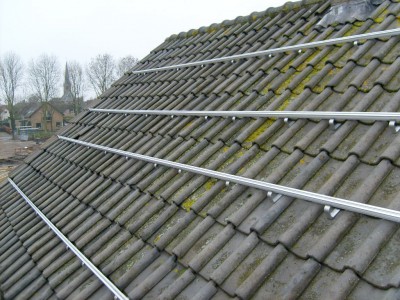
The ClickFit System for Mounting the Solar Panels
Then support rails are clicked onto the hooks. This was quite a difficult job. The clicking wasn’t very easy to do most times. After two people worked on it for 3 hours, all of the hooks and rails were in place.
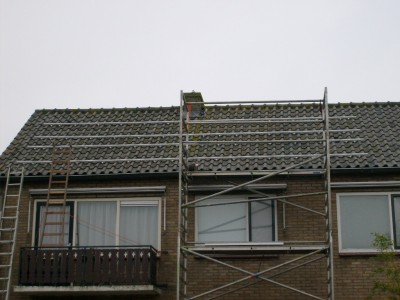
The Hooks and Support Rails are Mounted on my Roof
On the backside of the panels, plastic small blocks are screwed, by which the panels can be hooked on the rails, preventing the panels from sliding downwards during mounting .
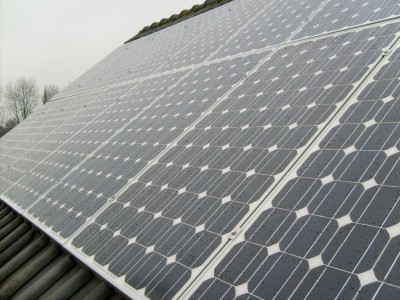
The Solar Panels are screwed onto the Rails
Mounting the 20 panels took about 4 hours work with 2 persons. The panels are electrically connected via watertight plugs.
The orientation of the roof is:
- Direction: south-southeast (154º)
- Slope: 40º
No shadow of buildings or trees can reach the panels. This is very important, as a small shadow on even one panel can quite reduce the power of the whole system.
The upper row of 10 panels are series connected. The lower row of 10 panels are also series connected. At the end of each row an electrical cable goes through the roof into the house.
The two rows of panels are connected to the inverter, which supplies the generated energy to the electricity grid. Both rows of panels have a voltage of about 360 Volt
This picture shows, at that moment 2006 Watt is supplied to the grid. The display can also show the total generated energy (number of kWh). This picture is taken on a sunny day in December around 11:30 AM, the sun’s altitude was quite low (<15º above horizon). When cloudy about 20 to 200 Watt is supplied at daytime.
For getting the subsidy, a production meter must be installed between the PV system and the electricity grid. The cable coming from the inverter of the PV system is connected to the electricity grid. A loop is taken up in the cable. Below some pictures about installing the production meter.
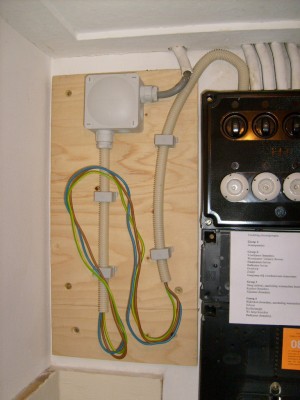
Preparations in the Electric Cabinet
A meter board of placed over the loop of cable. Until this point the preparations are done by myself.
After that, a mechanic of the grid administrator has installed the production meter.
The subsidy is given for every generated kWh, even if you are using this electricity yourself. For the year 2009 the subsidy is € 0.29 per kWh. Besides that, you also save the cost of the electricity.
To calculate the payback time of the system, I made a excel file in which I compare the yield of the PV system with the yield of a savings account. I tried to take as much as possible relevant factors into account. The calculations are based on the Dutch subsidy system, and Dutch tax system. In my case the pay back time is about 13 years. The calculations can be found in this Excel file. You can yourself change the yellow coloured fields, and see what happens with yields and payback time.
Since it was build in 1966, my house is wearing the Dutch name “Zonnehoek”. Which translated means “sunny corner”. After placing the solar panels, this is now an extra appropriate name.
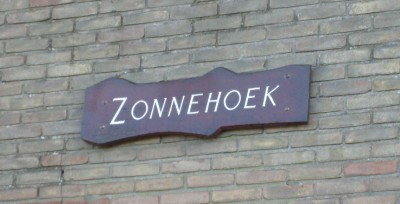
An extra appropriate name for my House
The system is put into use on December 1, 2008. Below the production of electricity for the first three months. The production in the following months can be found on my website
| The production numbers | ||
|---|---|---|
| Month | Generated energy this month (kWh) |
Total generated since December 1, 2008 (kWh) |
| February 2009 | 107 | 382 |
| January 2009 | 154 | 275 |
| December 2008 | 121 | 121 |
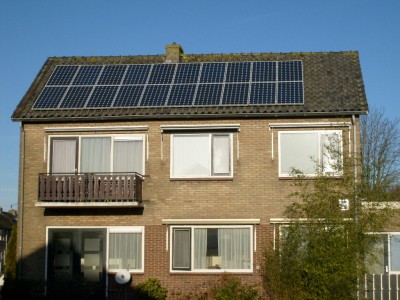
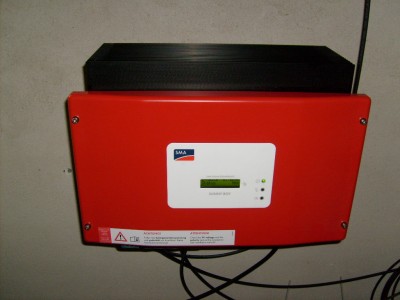
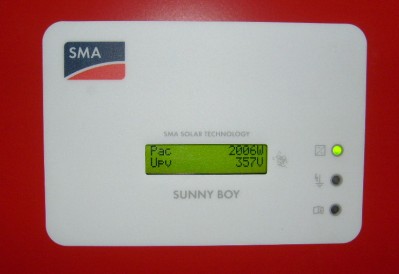
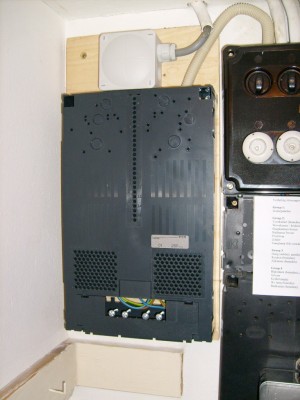
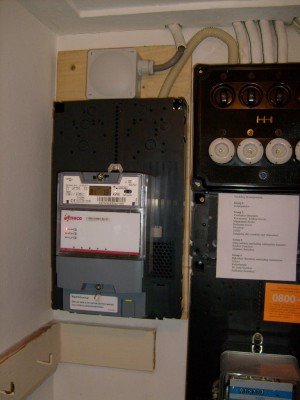



July 2nd, 2009 at 1:36 pm
It would be more enlightening if you had a column showing your consumption alongside production.
March 8th, 2010 at 12:18 pm
solar street light power systeem
March 23rd, 2010 at 4:07 am
I was trying to get the feed for the RSS for your site but it is not showing up in Google Chrome. Does anyone have any ideas?
March 23rd, 2010 at 4:23 am
Same problem here with Chrome under OSX. It seems that Chrome does not support RSS feeds yet. The feed works with Firefox.
April 5th, 2010 at 3:37 pm
Dear Sirs
I checked your website about the clear energy.
I would like to purchase a complete solar/wind power generator system to be independent with batterie storage.
My house in Lebanon at the mountain with a minimum of 12/mph wind speed, but sometime it could be 100mph, is that a problem?
I consume 3000 KWH/month.
A maximum of 8000w are used in the same time. (lights, Air-conditioning, garden watering, pool pumps, lift……).
I would like to receive a detailed quotation for a complete system.
Your quick reply is highly appreciated,
Sultan THOMAS